Jomon Journey of nawa to yajiri
English is available after Japanese.
For other languages, please click here
前編はこちら
法正尻遺跡を訪れたのは、その翌日の午前中のことだった。会津盆地は昨日降ったばかりの真っ白な新雪に満たされていた。畑や森が点在するのどかな風景をゆく。磐梯山の火山噴火でできたという地形は起伏に富み、車は何度かアップダウンを繰り返した。道を聞くために丘の上の観光牧場の建物に立ち寄ったが、外に出ると天気が雪に変わっていて唖然とした。これでは磐梯山と遺跡のショットが撮れない。大粒の雪がとめどなく降り注ぐ中、教えてもらった分岐を曲がると、骨組みだけのビニールハウスが並ぶ向こうに高速道路が見えた。この一帯が法正尻遺跡だ。
高速道路の橋脚下に車を止め、並行する脇道を右へ行くと、やがて池のある開けた場所に出た。もしかしたら、小さな畑があるのかもしれないが、真っ白な雪に覆われていて何があるのかわからなかった。周囲に広がる針葉樹の森の中に入ると、磐梯山の噴火で飛んできたのか、木々の間に大きな岩石がいくつも露出している。道を下っていくと森はすぐに終わり、畑の広がる場所に出た。そこに見えるはずの磐梯山は白くかき消えていた。
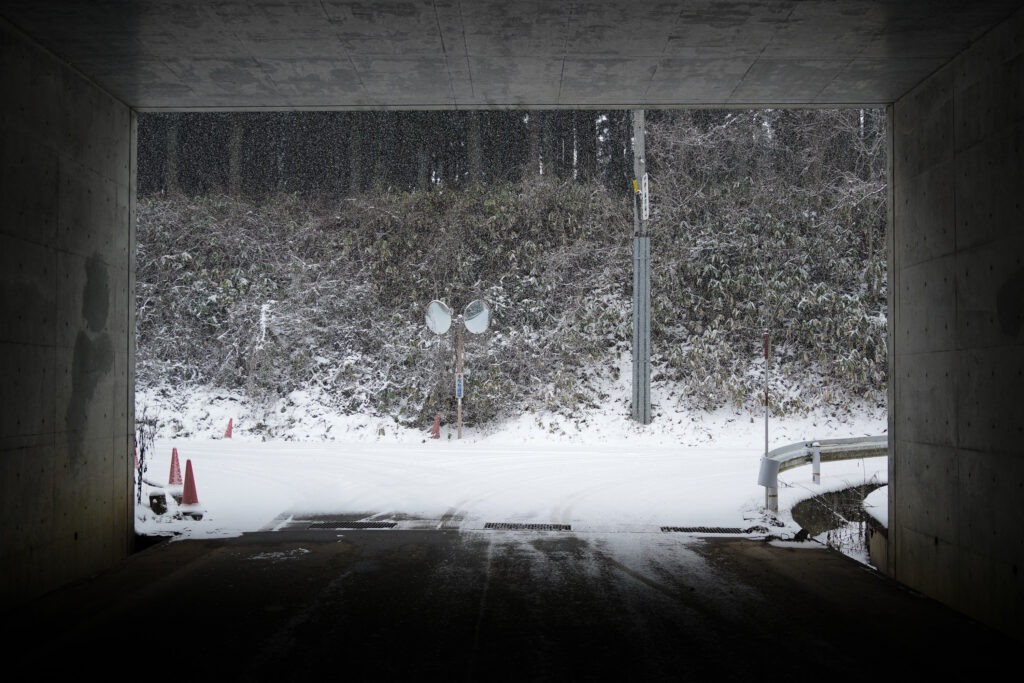
必然的に雪の日を過ごした縄文人のことを思う。大陸から吹き下ろす寒気が、日本海上空の湿った空気とぶつかり大量の雪を降らせるという日本海側気候は、この時代にはすでに始まっている。このようなしめった雪の重みでつぶれないように、住居はしっかりしたつくりでなければいけないだろうし、寒さから身を守るためには毛皮が必要だ。
食料についてはどうしていただろうか。木々の葉が落ちる冬は見通しがきくため、狩にはいい季節だと聞くが、エネルギー源となる木の実や根茎類などは保存しておかなければいけない。冬の間焚く薪も確保しなければならない。––––おそらく、法正尻ムラの人々は、そのすべてを協力し合いながらこなしていたのだろう。そうでなければ、このような大雪が降る土地で1000年間も暮らしは続かないだろう。
池のある場所まで戻り、雪でなんとなく土偶のようなものを作ってみた。こんな単純な遊びだけど、結構楽しい。法正尻ムラの子どもたちもこんな遊びをしたのかな。
その後、会津若松に向かい、学芸員のKさんに教えてもらった看板のないラーメン店で熱々の喜多方ラーメンを食べ、酒好きの友人に教えてもらった日本酒のセレクトショップで会津の地酒を買い込み帰路についた。
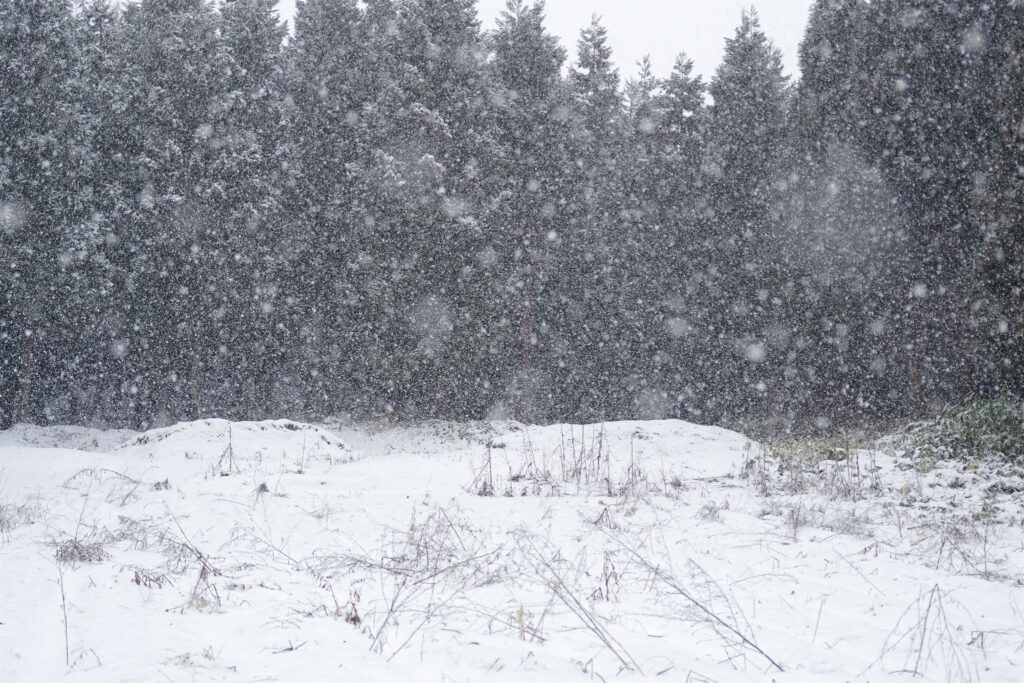
福島の旅を終え、東京で複式炉について書いている。あれは一体なんだったのか、結局わからずじまいだった。システムキッチンのようで、決して便利かどうかはわからないもの。答えは別なところにあるような気がした。そこで、まほろんの復元住居で複式炉をみたときの気持ちを思い出してみた。
これまで何回も竪穴住居に入ってきたし、竪穴住居の中でイベントをやらせてもらったこともある。しかし、あのときほどなんともいえない豊かな気持ちになったことはなかったかもしれない。ここで火を焚けば、何が作れるのか、ワクワクするような気持ちになったのである。それは、素朴な石囲炉を見たときには起こり得ない気持ちだった。
一方で、なだらかな曲線に沿って大小の石が密集して敷き詰められている様子には、異様さも感じられた。それは形のさまざまな石を積んだ石垣に圧倒される感じと似ている。石の集合体である複式炉には独特のオーラがあるのだ。
石は奥深い世界を秘めている。ペグマタイトにしめ縄をはった神社があるように、昔の人は目に見えない精霊や霊魂が依り憑く磐座として、石を神聖視してきた。とりわけ硬くて丈夫な石は、たとえ自分が死んでもずっと後世まで残るもの。そのような石の持つ永遠性を炉として昇華したものが複式炉だと考えてみてはどうだろう。
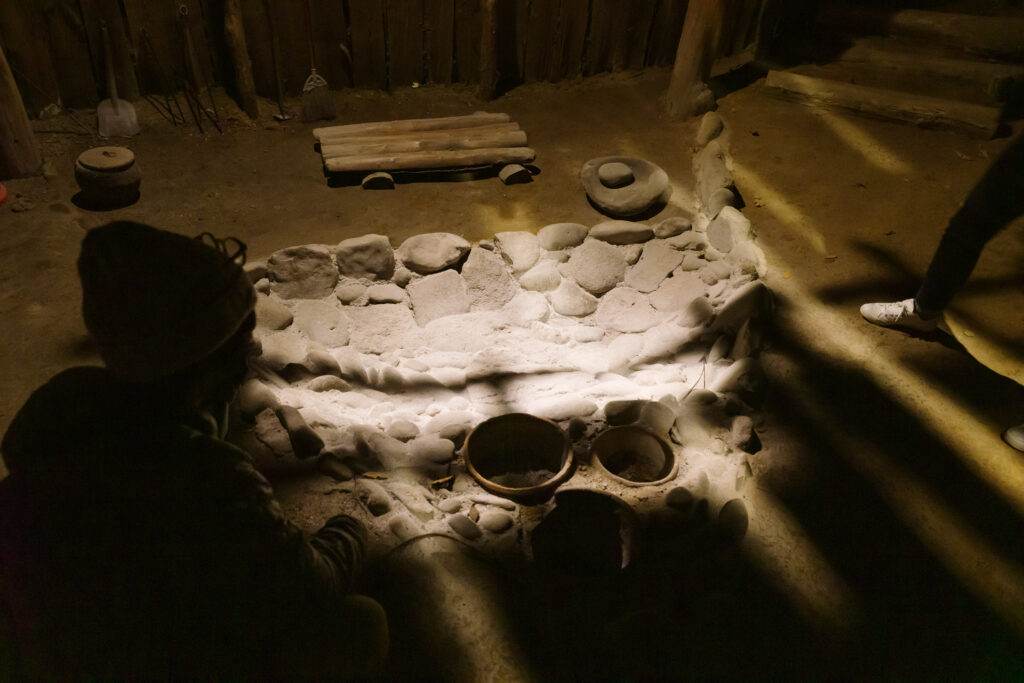
重要なのは、石に土器が埋め込まれていることである。土器は、食べ物を食べやすくするもの。アク抜きや煮炊きといった調理技術の確立は土器によって成し遂げられ、魚貝や肉、多種多様な山菜や木の実、きのこなどを食べる雑食が可能になった。そのままでは苦くて食べられないものが土器で煮ると食べられるようになるのだから、土器は自然界と人間界をつなぐ魔法の装置のようなものである。つまり、いくら文様が削ぎ落とされたとしても、土器が自然と人間の間にあり、命をつなぐ装置であることには変わりないのだ。複式炉とは、聖なる土器を硬い普遍的な物質である石の構造物に埋め込んだもの。つまり、土器と石が融合して、さらにパワーアップしているのである。
食料の獲得が自分たちの命と直結していることをよく理解していた人々にとって、自然界が豊穣で満たされることぐらい尊いことはない。それゆえに人は祈る。土器を美しく飾り、自然界に思いを伝えようとする。ある意味、縄文土器の文様とはもの言わぬ自然界に対する人間の意思表示であり、コミュニケーション手段だ。そのように文様を捉えると、複式炉の登場とともにこの地方の土器がシンプルな見た目になったのは、コミュニケーションの仕方を変えただけ。つまり、土器の装飾が担っていた豊かさの象徴が複式炉に移ったということが言えるのではないだろうか。

竪穴住居の炉は家の心臓のようなものだと思う。今でも私たちは活気を失って寂しくなる様子を「火が消えたようだ」と形容する。二本松市の原瀬上原遺跡で見たひしゃげた竪穴住居は、まさに火が消えたような寂寥感が漂っていた。火を焚かなければ、竪穴住居はカビや虫、動物の巣窟となり、やがて朽ちてしまう。だから、家が死なないように家の炉は火を焚き続けなければならないのだ。火もまた命をつなぐ神聖な存在なのである。
ある意味、複式炉は石、土器、火を融合させた三位一体型のパワフルな装置なのではないだろうか。豊かさが続くように、不幸が起きないように、人々は自然界と人間界をつなぐある種の聖域を各家に実装したのである。そして複式炉は、縄文時代の中期末に東北南部を中心に東日本の各所に広がった。私はそこに「石に情熱を注いだ」人々の大きなネットワークをみる。
もちろん、複式炉が何かは、学術的には解明されていない。しかし、確信しているのは、その石への情熱が、複式炉終焉後も途絶えることはなかったということだ。縄文時代後期に入ると、東北や北海道では石を同心円状に配置した巨大な環状列石の時代が始まる。いったい、この石への情熱はいつまで続くのやら。もしかして、あのペグマタイト神社のように現代にもひっそりと続いているのだろうか。
草刈朋子:文 廣川慶明:写真
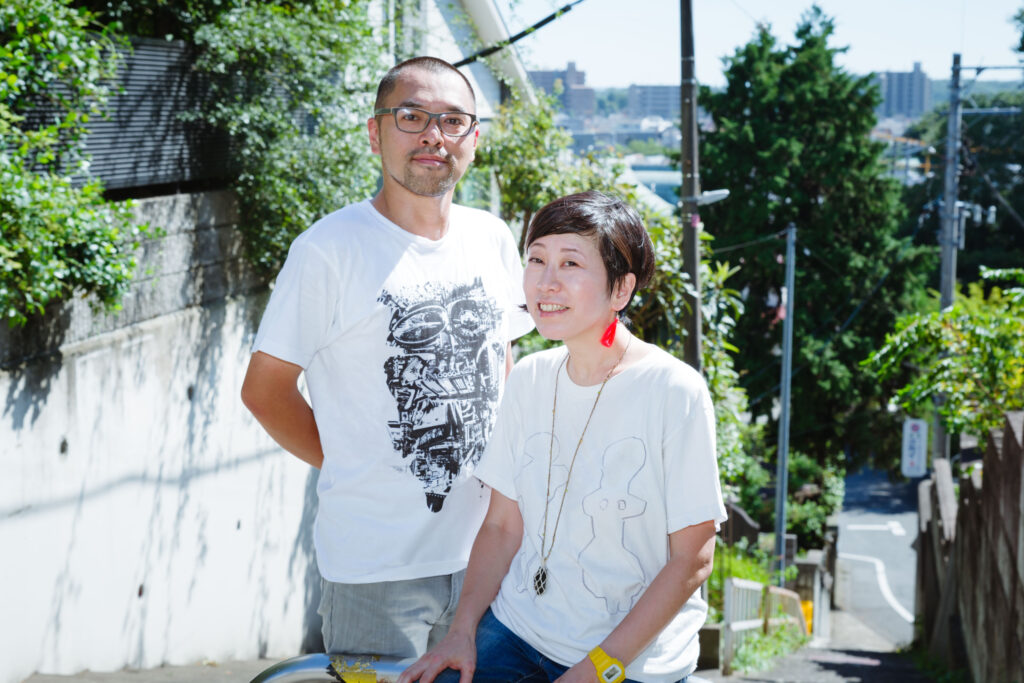
縄と矢じり
文章担当の草刈朋子と写真担当の廣川慶明による縄文探求ユニット。ともにNPO法人jomonismのメンバーとして活動するほか、全国の縄文遺跡と考古館や郷土館をめぐる縄文旅をしながら各地の縄文のカタチ、環境から読み解ける先史時代の価値観を探求中。
http://nawatoyajiri.com
Reading Part 1
*’Fukushiki-ro’ is a large-size fireplace constructed from an arrangement of large riverbed stones.
It was the morning of the following day when I visited the Hoshojiri Site. The Aizu Basin was filled with fresh white snow that had fallen only yesterday. We walked through a peaceful landscape dotted with fields and forests. The terrain, which was formed by the volcanic eruption of Bandai, was full of ups and downs, and the car went up and down several times. We stopped at a tourist farm building on a hill to ask for directions, but were stunned to find that the weather had turned to snow by the time we got out. This made it impossible to get a shot of Mt. Bandai and the ruins. As we turned at the fork we had been told to take in the incessant heavy snow, we could see the highway beyond the rows of plastic greenhouses with only their frameworks. This area is the Hoshojiri Site.
We parked our car under a highway pier and took a parallel side road to the right, which eventually led us to an open area with a pond. Perhaps there was a small field, but it was covered with a blanket of white snow, so I could not see what was there. As we entered the surrounding coniferous forest, we saw a number of large boulders exposed among the trees, perhaps blown in by the eruption of Bandai-san. As we descended the path, the forest soon ended and we came to an expanse of fields. Bandai, which was supposed to be visible there, had faded to white.

Naturally, I think of the Jomon people who spent snow days. The Japan Sea side climate, in which cold air blowing down from the continent collides with moist air over the Sea of Japan and causes large amounts of snow to fall, had already begun by this time. Houses would have to be solidly built so as not to be crushed by the weight of such wet snow, and furs would be necessary to protect against the cold.
What did they do about food? Winter is said to be a good season for hunting because the leaves fall off the trees, but we need to preserve nuts and rhizomes as a source of energy. We also need to secure firewood to burn during the winter. —-Perhaps the people of Hoshojiri community were cooperating with each other to do all of this. Otherwise, life would not have continued for a thousand years in a land of such heavy snowfall.
We went back to the pond area and tried to make something somewhat like a clay figurine out of snow. Such a simple game, but quite fun. I wonder if the children of Hoshojiri community also played this kind of game.
After that, I headed to Aizuwakamatsu, where I had hot Kitakata ramen at a ramen restaurant without a sign, which curator K told me about, and bought some local Aizu sake at a sake select store that a sake-loving friend told me about before heading home.

After my trip to Fukushima, I am writing about the Fukushiki-ro in Tokyo. In the end, I could not figure out what it was all about. It was like a system kitchen, but never sure if it was useful or not. I had a feeling the answer lay elsewhere. Then I remembered how I felt when I saw the Fukushiki-ro in Mahoron’s restored residence.
I have been in pit dwellings many times before and have been allowed to hold events in pit dwellings. However, I may have never felt as indescribably rich as I did then. I was excited to see what I could create if I built a fire here. It was a feeling that could not have happened when I saw a simple stone hearth.
On the other hand, the dense arrangement of stones of various sizes along gently curving lines seemed bizarre. It was similar to the feeling of being overwhelmed by a stone wall piled with stones of various shapes. The Fukushiki-ro, which is a collection of stones, has a unique atmosphere.
Stones hold a profound world. As in the case of shrines with shimenawa (sacred straw ropes) made of pegmatite, people in ancient times regarded stones as sacred rocks on which invisible spirits and souls dwelled. Especially hard and strong stones will remain for generations to come, even after one’s death. The fukushiki-ro is a sublimation of the eternal nature of stone.

Importantly, there are earthenware vessels embedded in the stone. Earthenware makes food easier to eat. The establishment of cooking techniques such as removing scum and boiling food was accomplished by earthenware, which enabled omnivores to eat fish, shellfish, meat, a wide variety of wild plants, nuts, and mushrooms. Earthenware is like a magical device that connects the natural world and the human world, because things that are bitter and inedible as they are can be eaten when boiled in earthenware. In other words, no matter how much the patterns are stripped away, earthenware remains a device that connects life between nature and humankind. A Fukushiki-ro is a sacred earthenware vessel embedded in a structure of stone, a hard universal material. In other words, the earthenware and the stone are fused together for added power.
For those who understood well that the acquisition of food was directly connected to their lives, there was nothing more precious than for the natural world to be filled with abundance. Therefore, people pray. They decorated earthenware beautifully to convey their thoughts to the natural world. In a sense, the patterns on Jomon earthenware are an expression of man’s intentions toward the unspeaking natural world and a means of communication. In a sense, the patterns on Jomon earthenware are an expression of human intention toward the unspeaking natural world and a means of communication. If we look at the patterns in this way, the fact that the appearance of earthenware in this region became simpler with the advent of the fukushiki-ro is simply a change in the way of communication. In other words, it can be said that the symbol of affluence, which had been carried by the decoration of earthenware, has been transferred to the fukushiki-ro.

I think the furnace in a pit dwelling is like the heart of the house. Even today, we describe the loss of liveliness and loneliness as “the fire seems to have gone out” The crushed pit dwellings we saw at the Harase-Uwahara Ruins in Nihonmatsu City gave us a sense of desolation, as if the fire had truly gone out.. The crushed pit dwellings we saw at the Harase-Uehara site in Nihonmatsu City gave us a sense of desolation, as if the fire had truly gone out. Without fire, the pit dwellings would become dens of mold, insects, and animals, and eventually decay. Therefore, the furnace of the house must keep the fire burning so that the house will not die. Fire is also a sacred entity that connects life.
In a sense, the compound furnace is a powerful trinity of devices (units) that fuse stone, earthenware, and fire. People implemented a kind of sanctuary in each house to connect the natural world and the human world so that affluence would continue and misfortune would not occur. The Fukushiki-ro then spread to various parts of eastern Japan, especially in the southern Tohoku region, at the end of the middle Jomon period. I see there a large network of people who were “passionate about stones”.
Of course, what a Fukushiki-ro is has never been academically clarified. What is certain, however, is that this passion for stone did not cease even after the demise of the fukushiki-ro. In the late Jomon period, the era of the huge annular stone blocks, in which stones were arranged in concentric circles, began in the Tohoku and Hokkaido regions. One wonders how long this passion for stones will continue. Perhaps, like the pegmatite shrines, it continues quietly into the present day?
Tomoko Kusakari : Text, Yoshiaki Hirokawa : Photo
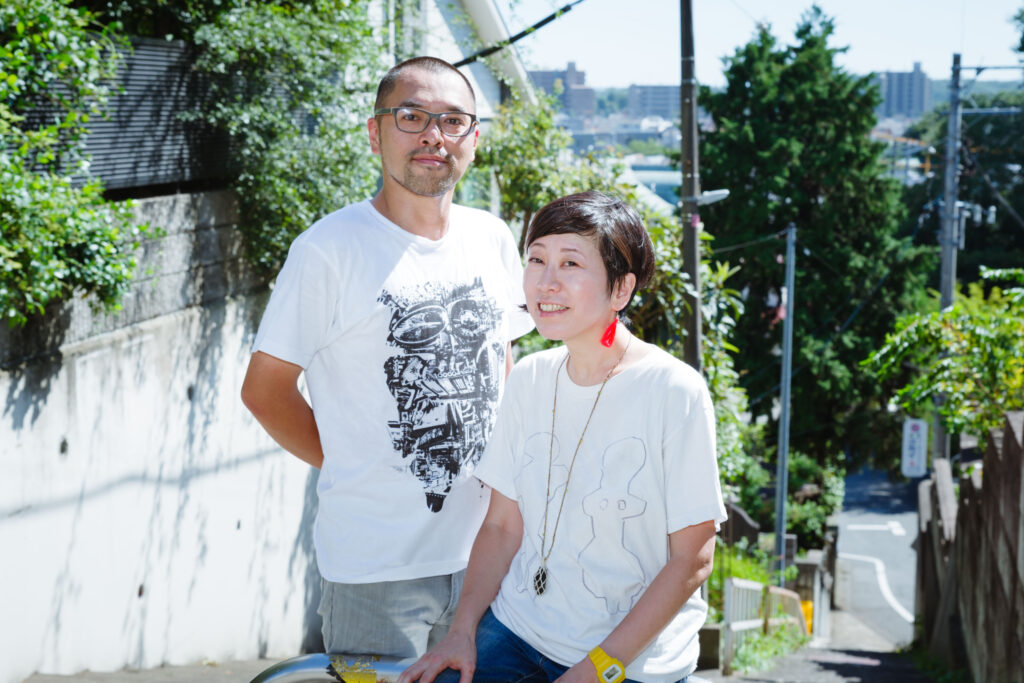
nawa to yajiri
(it means “Rope and Arrowhead”)
A unit for exploring the Jomon by Tomoko Kusakari (writing) and Yoshiaki Hirokawa (photography).
In addition to working as members of the NPO Jomonism, they also travel around Japan visiting Jomon ruins, archaeological sites and local museums, exploring the prehistoric values that can be deciphered from the forms and environments of the Jomon.
http://nawatoyajiri.com